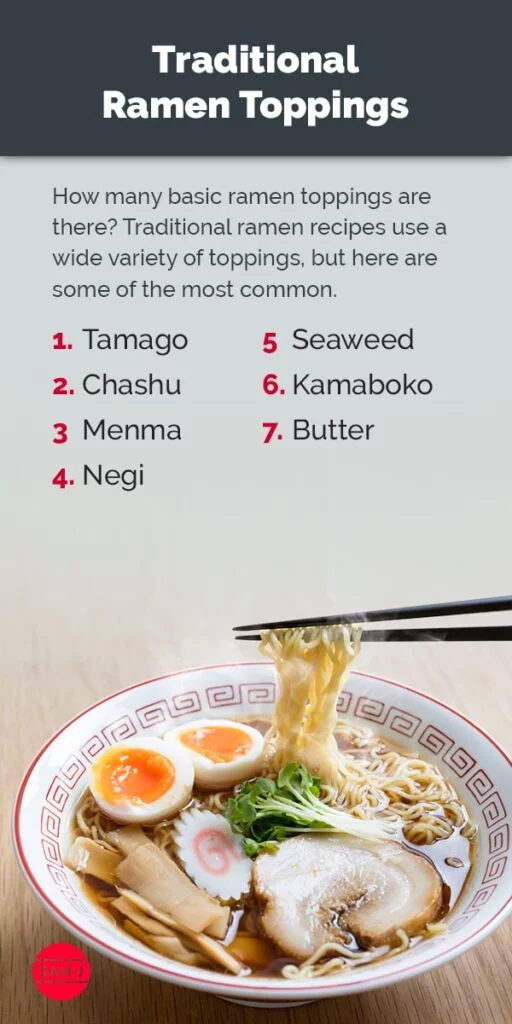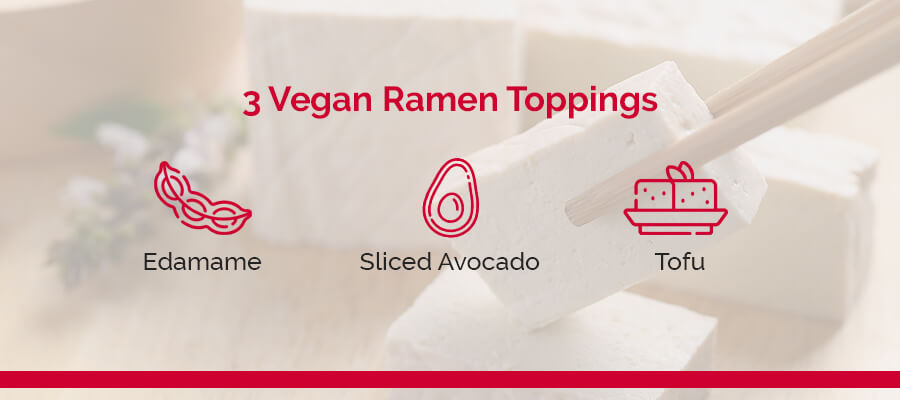While it’s a staple in Japanese cuisine, ramen is a wildly popular comfort food around the world. It’s super versatile and always evolving, with new toppings and recipes popping up all over the internet.
Want to make your own delicious noodle soup and wondering how to up your ramen game? Use this ramen bowl toppings list to help you get started.
Best Ramen Toppings

Traditional Ramen Toppings
How many basic ramen toppings are there? Traditional ramen recipes use a wide variety of toppings, but here are some of the most common ramen add-ins.
1. Tamago
“Tamago” is Japanese for “egg.” In ramen, they’re usually either hard- or soft-boiled, but a chef might add a raw one to the soup while it cooks.
Boiled eggs are often marinated in a mixture of soy sauce, mirin, vinegar and sugar, which colors the whites a light brown. These marinated eggs are also called “ajitsuke tamago,” which translates to “seasoned eggs.” You might also see them referred to by their abbreviated name, “ajitama.”
In addition to making a delicious ramen topping, ajitama is also commonly used as a topping for donburi (rice bowls) or served as an appetizer with alcoholic beverages like beer or sake.
2. Chashu
Chashu is thinly sliced cuts of roasted or braised pork. It’s one of the most popular ramen toppings, so if you order ramen in Japan, you’ll probably find one or two pieces in your bowl. There’s even a name for ramen containing a lot of chashu — “chashu-men.”
The flavor of your chashu depends on the cut you choose:
- Butabara: The richest and fattiest type of chashu, butabara is made from thin slices of pork belly. Some ramen chefs will swap it for kakuni, which is braised pork belly cut into thick strips or cubes.
- Rosu: A much leaner loin cut that provides a meatier flavor and texture, “rosu” is best for anyone who doesn’t like highly fatty foods.
- Katarosu: “Katarosu” is a shoulder cut that strikes a nice balance between the fattiness of butabara and the meatiness of rosu.
For those who can’t or don’t like to eat pork, you can also find chashu made from duck, beef or chicken.
3. Menma
Menma is fermented bamboo shoots. It has a briny, nutty flavor and a sweet crunch. Menma is also packed with fiber, which makes the dish even more satiating. You can usually find menma at Asian grocery stores or online. While menma is typically safe for vegetarians, you might still want to check the ingredients to make sure it contains only vegetarian seasonings if you follow a vegetarian diet.
4. Negi
“Negi” is the Japanese word for Japanese long green onions, which usually comes shredded or chopped. While negi looks like leek, it has a more robust, spicier taste that tends to mellow when cooked.
The shredded white stalk adds an interesting texture to ramen, and the chopped green tops provide a striking garnish. You can also add a little kick to your ramen recipes with karanegi — shredded Japanese long green onions coated in chili oil.
5. Seaweed
With a coastline spanning thousands of miles, it makes sense that seaweed is a staple ingredient in Japanese cooking. Its briny, salty flavor goes well with every type of ramen, and it looks visually striking when folded in the corner of the bowl.
You’ll find many types of seaweed in Japanese cuisine, but the two most often used for ramen are:
- Nori: Nori is dried seaweed sold in flat sheets. It’s also used in dishes like sushi and onigiri or eaten as a healthy snack.
- Wakame: Wakame is a type of seaweed that typically comes in cut and dried. You usually need to rehydrate it before use. It’s a little more versatile than nori and can be used in salads, stir-fries and soups.
Nori is relatively inexpensive and easy to find at most grocery stores, making it one of the best ramen toppings for home cooks. Wakame is usually sold at Asian stores and it’s also readily available online.
6. Kamaboko
You might have noticed that ramen often comes with little pink and white pinwheels on top. These are naruto, one of the most popular types of kamaboko for a ramen topping.
Kamaboko is a steamed fish cake made from surimi paste, which is a mix of different fishes, starches, egg white and seasonings.
While you might expect naruto to have a strong, fishy flavor, it’s actually quite mild. It’s similar to imitation crab meat — kanikama — which is slightly chewy and a little sweet.
7. Butter
Butter is a surprising yet delicious topping that’s most popular in northern Japan. Adding a pat of butter to miso-based ramen lends it a rich, creamy texture and deepens the broth’s umami flavor. It also helps cut the spiciness in stronger broths.

4 Ramen Condiment Options
To add some extra flair, ramen chefs may drizzle sauce on top. Here are some of our favorite choices.
1. Rayu
Rayu is a Japanese chili oil made by infusing sesame oil with red pepper, green onions, garlic and spices. While you can sometimes find it in stores, you can also make your own at home.
When added to ramen, rayu imparts a rich, smoky heat that few other sauces can match. It’s also commonly used to add flavorful spiciness to Chinese-style dishes, or as a dipping sauce for gyoza.
2. Yuzu Kosho
Yuzu kosho is a Japanese condiment from the Kyushu region. Made with yuzu peels, fresh chilis and salt, this tasty condiment has been a secret favorite in many chefs’ kitchens for years. The combination of fragrant yuzu and spicy green chili adds delightful flavor to any dish — including a bowl of ramen.
3. Gochujang
Gochujang is a rich, fermented Korean chili paste with a sweet, smoky flavor. Standard gochujang is only mildly spicy, but you can often find more intense varieties in the international aisle of your local supermarket.
If you love spice, you can also try combining gochujang with sriracha for a condiment that will delight your taste buds.
4. Homemade Condiments
If you have some extra time on your hands, you can make your own ramen sauce. Here’s a quick recipe for an easy sesame garlic sauce:
- Heat 2 tablespoons of toasted sesame oil in a skillet over medium heat, then add two cloves of minced garlic and stir. Cook for two minutes, stirring constantly.
- Remove the pan from the heat.
- Whisk in 2 tablespoons of Tamari, 1 teaspoon brown sugar and 2 teaspoons sriracha until well combined. Taste and adjust ingredients as needed.
This recipe will beautifully complement a simple shoyu or shio ramen with its nutty aroma and subtly smoky flavor.
2 High-Protein Ramen Add-Ins
High-protein toppings can help you meet your nutritional goals while enjoying the foods you love. Here are some suggestions.
1. Pork
Pork is a classic choice because it’s high in protein and important vitamins and minerals. It’s also fairly low in calories, especially when compared to other meats like chicken and beef.
At just over 6 grams of protein per ounce, chashu pork is an excellent topping choice for anyone following a high-protein diet. If you’re watching your macros, opt for leaner cuts like rosu or katarosu.
2. Seafood
Seafood can help you up your protein intake without consuming too many calories. There’s always the option to add a few slices of kamaboko, which adds 3.4 grams of protein per piece. If you’re looking for something a little less traditional, here are some suggestions:
- Scallops
- Prawns
- Clams
- Haddock
- Cod
- Halibut
- Flounder
- Tilapia
As a general rule, stick to leaner, more neutral-tasting seafood to maximize protein and balance the flavors in the dish.
3 Ramen Toppings That Add Extra Flavor
What toppings can you put on ramen to enhance the flavor? Here are some classic suggestions.
1. Furikake
Furikake is a versatile Japanese seasoning made from sesame seeds, dried fish flakes, herbs, seaweed and salt. Its name comes from “furikakeru,” the Japanese word for sprinkles. It has a uniquely salty, nutty taste and a briny aroma, thanks to the seaweed.
You can use furikake for almost anything, so it’s a great seasoning to have on hand if you love to cook. It’s readily available at most Asian grocery stores, but you can also find it online.
2. Kimchi
Want to really spice things up? Try adding a helping of kimchi to your bowl.
Kimchi is a traditional Korean fermented dish made from an assortment of vegetables and spices. It usually contains cabbage and carrots and comes in various flavors, including sweet, spicy and sour. Because it’s fermented, it also contains probiotics, which are great for gut health.
3. Ginger
Ginger can brighten up your bowl in so many ways. Fresh slices of ginger add a nice, crunchy zing to your noodles that cuts the intense umami of tonkotsu or shio ramen broth. You can also grate or mince fresh ginger and sprinkle it on top for some extra flavor.
For a little more contrast, try adding beni shoga. This bright red pickled ginger is fermented in ume plum vinegar, creating a sour, tangy flavor that beautifully complements the ramen. You can find it in most Asian supermarkets, or you can make it at home if you have a little more time.

3 Vegan Ramen Toppings
If you don’t eat animal products, it can be hard to find plant-based substitutes with similar textures and flavors. Here are some of our favorite vegan ramen topping ideas.
1. Edamame
While edamame is a less traditional ramen topping, it’s great for vegans. Fresh soybeans are high in protein — just a cup of edamame contains more than 18 grams of plant protein, making it a healthy addition to your ramen. Edamame also adds a firm, chewy texture that complements the noodles well.
2. Sliced Avocado
Fresh avocado has a neutral taste and a rich, creamy texture, so it’s a good plant-based alternative to butter for miso ramen. Avocado will also make your dish stand out visually. Its bright green flesh adds a cool, eye-catching pop of color to your noodles you won’t find in many other fruits. Pair it with something red, like dried red pepper flakes or bell pepper, for a striking contrast.
3. Tofu
Crispy tofu on ramen is a game changer — and it’s an effective way to get in some plant-based protein.
First, cut a block of firm tofu into cubes and coat it with equal parts corn starch, olive oil and Tamari Soy Sauce. Then, pan-fry or bake it to your liking before adding it to your ramen.
You could also add silken tofu to the broth, like in a traditional miso soup, if you prefer something a little more subtle.
Best Toppings for Instant Ramen
Most instant ramen packets come with basic seasoning and a few dehydrated pieces of seaweed or green onion, but that’s not quite enough for a truly satisfying meal. Adding these easily accessible toppings will bring your instant ramen to the next level without requiring too much extra cooking time.
1. Homemade Ajitama
Ajitama is an easy make-ahead topping, making it the perfect match for instant ramen. Just boil your eggs to your liking and let them soak in the marinade overnight. Any extra eggs also make a tasty grab-and-go snack for the rest of the week.
2. Cheese
Cheese is a simple yet unexpected topping that goes great with instant ramen. It melts quickly and provides a creamy, gooey layer that stretches and pulls with every bite.
White or yellow American cheese is the most versatile choice, but you can also use Swiss, provolone or mozzarella if that’s what you have on hand. Each kind of cheese will create a different flavor combination, so feel free to try new combinations to find your favorites.
3. Bok Choy
Did you know ramen can help you get your greens in? Bok choy, sometimes spelled “pak choi,” is a Chinese white cabbage with a mild, slightly bitter flavor. Topping your bowl with sauteed or stir-fried bok choy adds a light crunch and tons of vital nutrients, like vitamin C, iron and magnesium.
For a deeper flavor, you can cook your bok choy in toasted sesame oil or another mild sauce. Don’t have bok choy on hand? Baby spinach works well in a pinch.
3 Classic Ramen Topping Combinations
Ramen is a flexible dish you can easily make your own with different toppings and combinations. Here are some more traditional ramen toppings to get you started.
1. Corn, Beansprouts and Butter
This combination is popular on miso ramen, which is a thick, hearty variation that comes from Sapporo, in Japan’s northern Hokkaido prefecture. The corn and beansprouts add sweetness and crunch while the creamy butter melts into the broth and deepens the umami flavor. It’s the perfect combination to keep away the chill on a cold winter night.
2. Chashu, Menma and Stir-Fried Vegetables
You’re most likely to find this classic combo atop a steaming bowl of shio ramen. Shio ramen has a clear broth with a briny, savory flavor. The menma and stir-fried vegetables add texture and umami flavor, while the tender chashu adds a rich, slightly sweet protein boost.
3. Chashu, Nori and Ajitama
If you love the most popular, classic flavor profile of Japanese ramen, this combination is for you. The narutomaki adds a cute pop of color and a springy mouthfeel, while the nori and ajitama intensify the savory, umami flavor. This ramen topping is excellent for enhancing shoyu ramen.

Create Delicious Homemade Ramen With SAN-J International
Need inspiration for what to add to ramen? At SAN-J, we make Tamari Soy Sauce and authentic flavored sauces that capture the umami-rich flavor of traditional Japanese cuisine. Unlike most soy sauces, which can contain up to 60% wheat, Tamari Soy Sauce is brewed with 100% soy. This gives the soy sauce a richer, more complex flavor that’s perfect for making ramen broth and toppings.
Using a flavor-infused Tamari can add even more complexity to your ramen. For spicy broths, try a citrus-infused sauce to cut some of the heat, or to add complexity to a milder ramen, you could try an umami-flavored variety. Browse our wide selection of sauces to get started.
Back to Top
